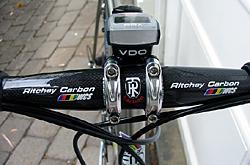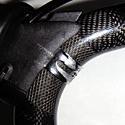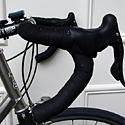
Recently on Cyclingnews.com |
Tech review - January 12, 2005
Ritchey WCS Carbon road handlebars

|
Stiffer than stiff - Steve Beletich rides Ritchey's new carbon fibre road handlebars and likens them to his old Ritchey alloy bars on Viagra.
Although probably best known as a manufacturer of mountain bike bits, Tom Ritchey has been designing and constructing road bikes and associated componentry since the mid seventies, when mountain biking was a mere glint in the eye of cyclocross. Ritchey's latest addition to their road handlebar range is the WCS Carbon, which is currently being used by the likes of Gerolsteiner, FDJeux, Credit Agricole and Saunier Duval.
The new WCS Carbon bars are constructed from 1.5 K Carbon, with a novel titanium mesh inlay around the brake lever clamping area. They have a 31.8mm centre section and are available in an anatomical and 'classic' bend, in sizes of 40, 42 and 44cm (c-c). The drop is 144mm and reach is 82mm (c-c) on all models and according to Ritchey, the 42cm bar weighs 205g and all models exceed DIN and DIN+ testing standards.
Show us your carbon bits
One of the benefits of buying a bike from a large and respected retailer is that you are virtually unlimited in your choice of components. I was fortunate enough to spec a new machine recently, and opted for a set of Ritchey WCS anatomical alloy handlebars. Two things attracted me to these bars. Firstly, they have a convex-shaped section in the drops which snugly fits my concave-shaped palm. Secondly, they were used by Jean Delatour, Credit Agricole and Gerolsteiner in the 2003 Tour de France (yes, sponsorship does work). I really love these bars - they are light, stiff and very comfortable.
Quite coincidentally, I was asked to review the new Ritchey WCS Carbon bars. These are similar in design to the WCS alloys, except the anatomical version has straight rather than the aforementioned convex drops. I considered this a slight detraction but the new bar did have compensatory benefits. Did I mention they're made of carbon fibre?
Depending on what you read and who you believe, people's perception of carbon fibre handlebars is changing. It seems that many cyclists are beginning to accept them as relatively safe, mainstream products, which is a story analogous to the carbon fork saga. Hearing this from various sources reassured me a little, and I was prepared to give the Ritchey Carbons a shot.
Even before I bolted them on, the WCS Carbon bars felt incredibly rigid. Using my Superhuman strength and giving the bar ends a good squeeze inwards, I could not make them budge, whereas my old bars I could bend ever so slightly.
Installation was straightforward, except I was VERY careful not to over-tighten the stem. Best to make sure that you use the torque settings recommended for your bar/stem combination here. Although in my opinion you have to be careful with torque settings - whether you are using a lubricant, anti-seize or nothing at all on the threads can significantly effect the actual bolt tension for a given torque. If in doubt, leave it to a bike mechanic you trust.
The only other points worth noting during installation were that the centre section has a rough texture to provide better stem grip (although our test unit didn't - this is a recent production change). The region where the brake levers bolt on is also inlayed with a woven titanium mesh, presumably to reinforce the high stress area created when you put weight on the hoods.
In my attempt to show off the carbon fibre, I did not wrap the last two inches of the bar ends with tape. I found out PDQ that the carbon overlay is very slippery, and re-taped the bars after just one ride. I did, however, leave a significant centre section of carbon fibre untaped - if you've got it, flaunt it.
Viagra anyone?
After several training rides and one criterium road race, all I can say is that these are extremely stiff bars. I noticed the contrast with my old alloy bars right away, and they're no wet noodle by any stretch. I even won the sprint for the first time in ages.
I don't know how much was imagination, but I honestly felt I had more power out of the saddle when sprinting and honking uphill. I equated the feeling to welding a piece of 6/4 titanium pipe directly across the head tube. It seemed that there was absolutely no give in the bars whatsoever. Push down on one side of the bar and the bike responds immediately. Rock solid.
Of course, if you stiffen your handlebars, the rigidity of the stem then becomes apparent. No point attaching these bars to any old papier mache stem - they scream to be gripped by a high-end unit, which I soon discovered. Worth noting too that a shorter stem will also increase power transfer, in theory at least.
The stiffness of the WCS Carbon bars inevitably brought me to the question of how they would transmit road vibration. In this department I did notice a very slight increase in road buzz, although I am riding a 3/2.5 titanium frame with carbon forks, forgiving wheels and fi'zi:k bar gel, which all help.
The verdict
Previously, I was of the firm opinion that carbon fibre handlebars were not for the faint of heart. Strictly for the boys at Credit Agricole and Gerolsteiner. However after riding these bars and observing that the world did not come to an abrupt end, I'm a convert. Power transfer is mind-blowing and road vibration is minimal. The only issues to be aware of are things like over-clamping the stem, and inspecting the bars after any significant impact. However this is sound advice for any carbon-fibre component.
Recommended retail price: US$ TBC
Claimed weight: 205g (42cm bar)
Materials: Carbon fibre, titanium mesh
Pro: Rigidity
Con: Sensitivity to clamping forces and impacts
More information: www.ritcheylogic.com
Cyclingnews Rating: ![]()





